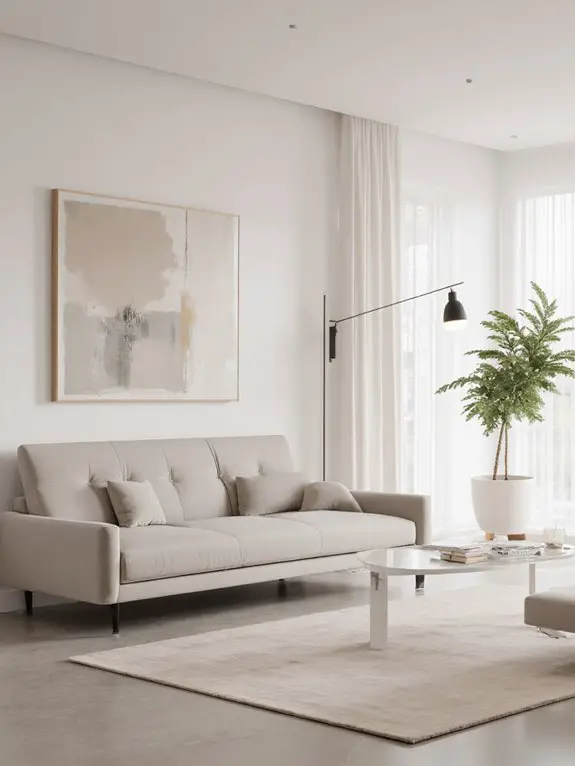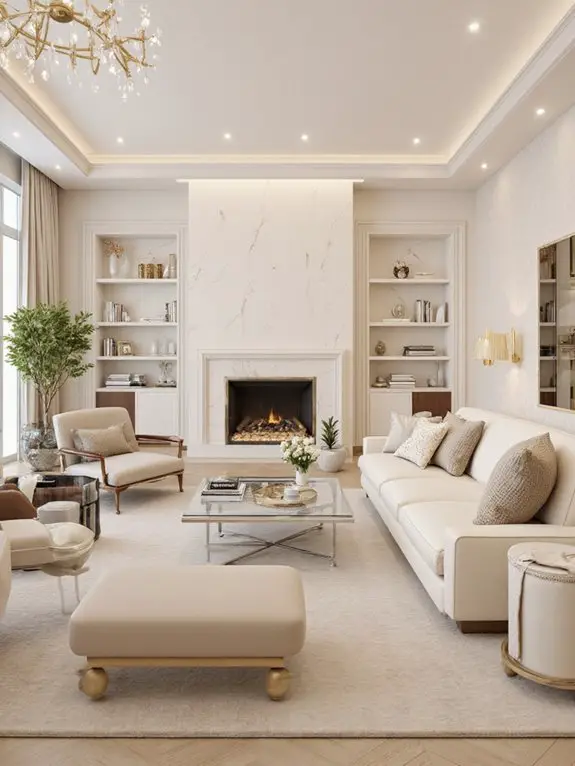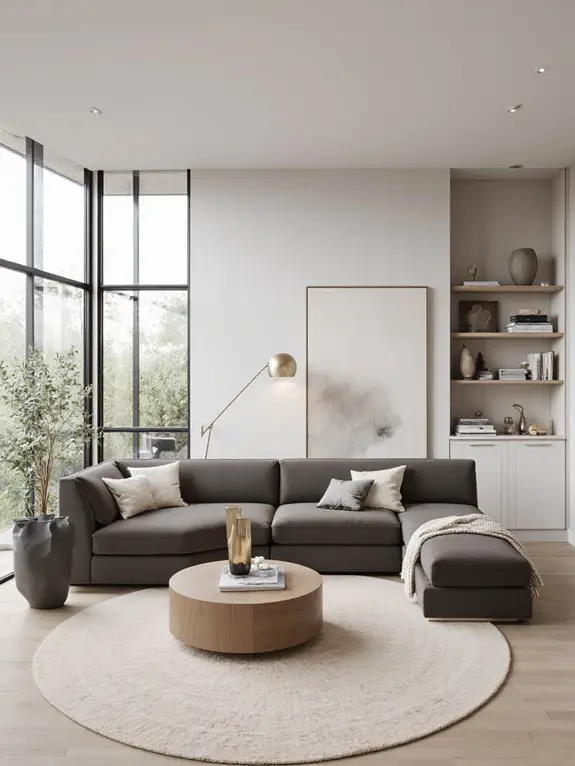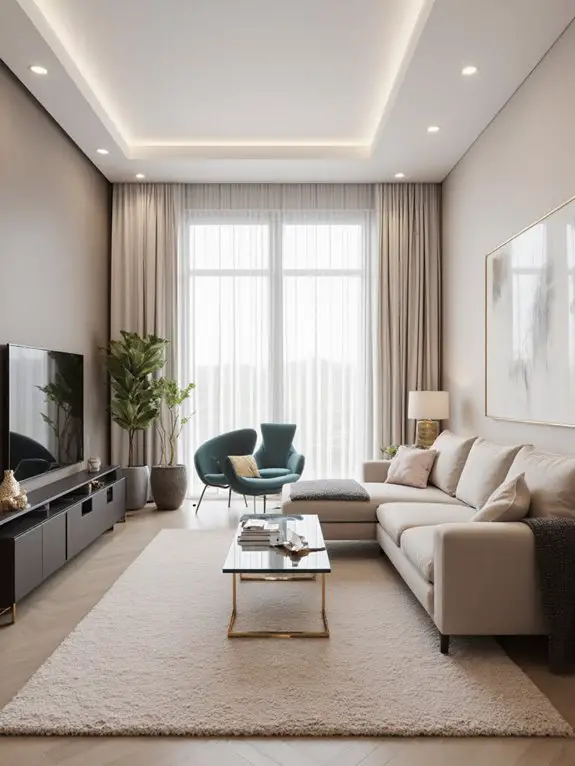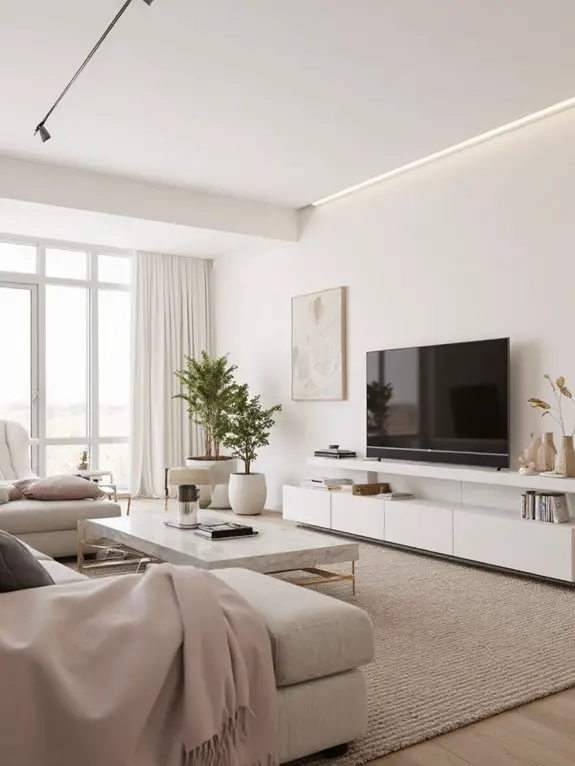Modern minimalist living rooms blend simplicity and elegance through clean lines, neutral palettes, and intentional design. I love how serene white walls paired with warm wood accents create timeless harmony, while high-contrast black-and-white schemes add bold drama. Open layouts with natural light enhance spaciousness, and compact urban spaces benefit from multi-functional furniture. Textured neutrals and subtle decor keep the look uncluttered yet inviting. There’s much more to explore in these stunning designs.
Serene White and Wood Interplay
A serene white and wood interplay creates a calming yet visually striking foundation for modern minimalist living rooms. I find that pairing clean white walls with warm wooden accents brings a natural elegance to the space.
It’s a balance I achieve by using light oak furniture or a reclaimed wood coffee table. Textured elements like a woven rug or linen throw soften the simplicity, making the room inviting.
I keep accessories minimal—a few potted plants or a single piece of art adds just enough personality. This approach feels timeless, letting the materials speak for themselves while maintaining a clutter-free aesthetic.
Sleek Monochrome Elegance
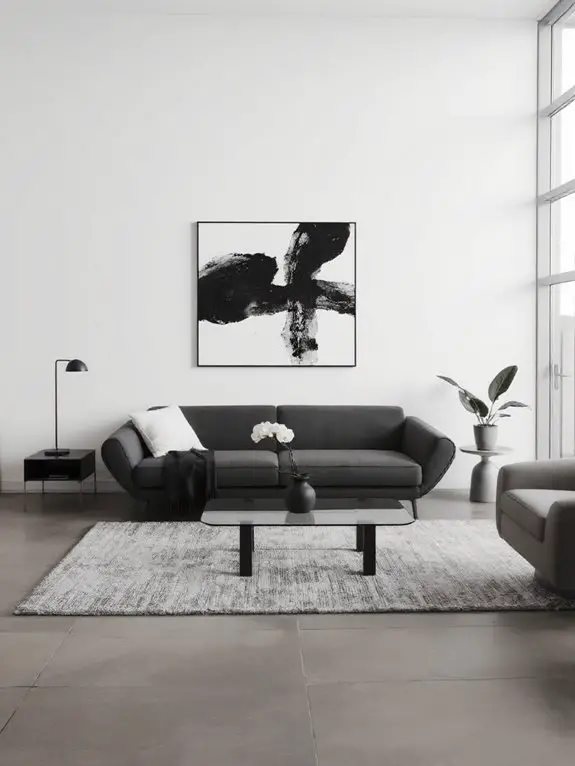
Sleek monochrome elegance transforms living spaces into sophisticated sanctuaries by embracing a single-color palette with precision. I love how this approach creates a cohesive, visually seamless environment that feels both modern and timeless.
By sticking to shades of black, white, or gray, you’re able to layer textures and materials without overwhelming the space. Think matte finishes paired with glossy accents, or velvet cushions against a sleek leather sofa.
The key is balance—avoid monotony by playing with scale and proportion. Minimalist lighting and clean-lined furniture enhance the effect, making the room feel curated and intentional.
It’s design distilled to its purest form.
Open-Plan With Natural Light
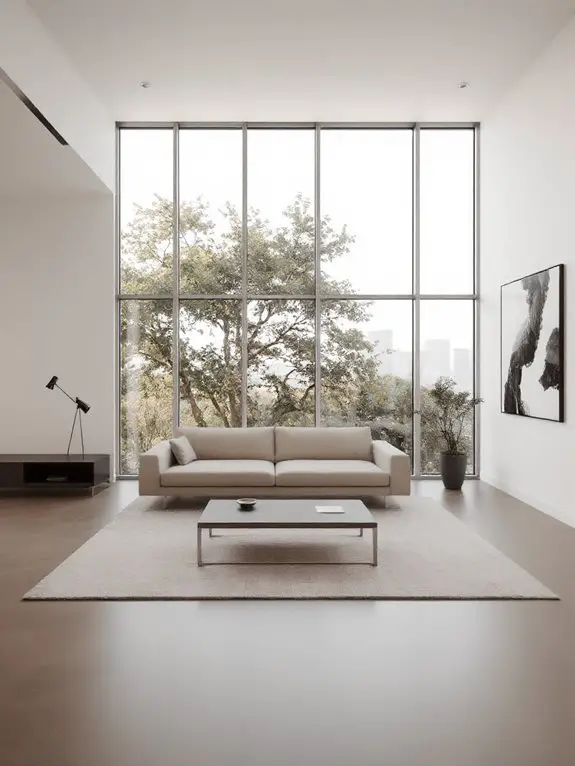
Embracing an open-plan layout infused with natural light can elevate a minimalist living space by creating an airy, expansive feel. I’ve found that removing unnecessary walls lets sunlight flow freely, making the room feel larger and more welcoming.
Floor-to-ceiling windows or skylights are my go-to for maximizing light, while sheer curtains soften glare without obstructing the view. Positioning furniture to avoid blocking light pathways guarantees every corner feels bright and open.
I also recommend using reflective surfaces like glass or polished materials to bounce light around. This approach not only enhances the room’s aesthetic but also fosters a calming, uncluttered ambiance.
Neutral Tones and Textured Accents
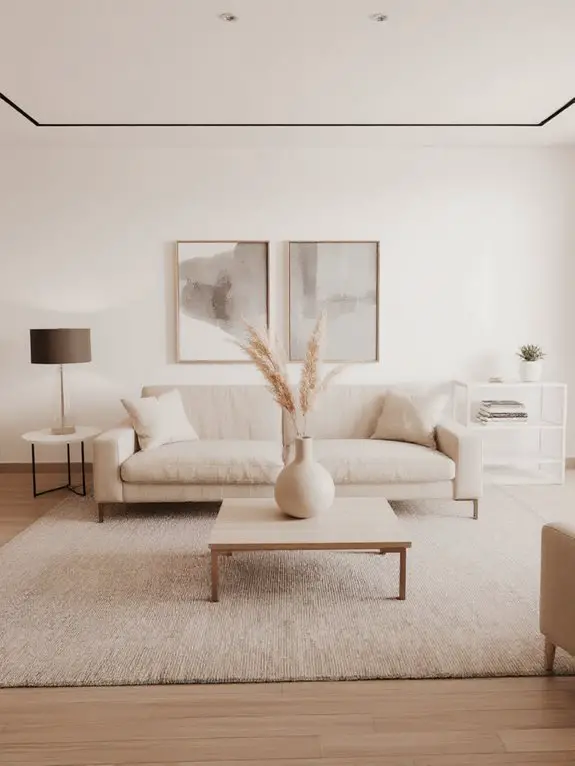
While neutral tones form the backbone of minimalist design, they don’t have to feel flat or monotonous. I always layer shades like beige, taupe, and ivory with subtle contrasts to add depth.
To keep it from feeling stark, I introduce textured accents—think a chunky knit throw, a woven rug, or linen cushions. These elements add warmth and visual interest without overwhelming the space.
I also play with matte and glossy finishes in furniture or decor to create subtle dimension. It’s about balancing simplicity with richness, ensuring the room feels serene yet inviting.
Texture, done right, makes minimalism cozy.
Compact Urban Minimalism
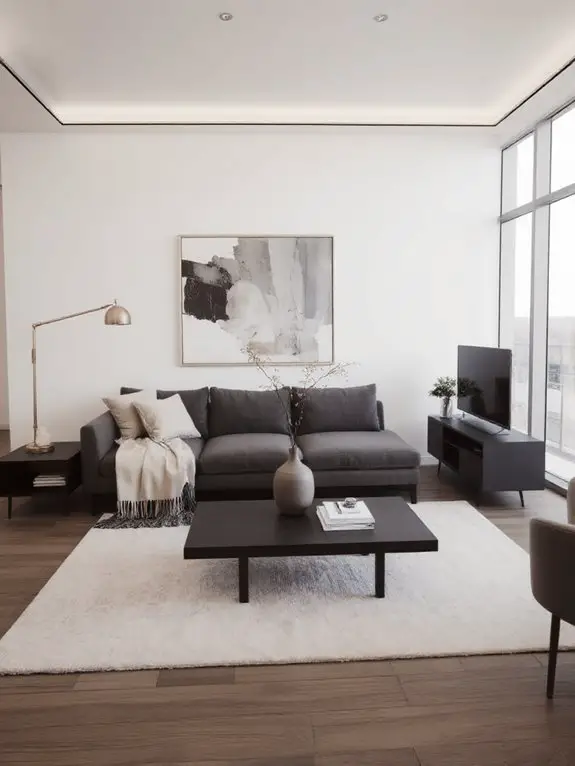
In smaller urban spaces, minimalist design isn’t just an aesthetic choice—it’s a necessity to make the most of limited square footage. I focus on multi-functional furniture like sleek sofa beds and nesting tables to maximize utility without clutter.
Vertical storage, such as wall-mounted shelves, keeps floors clear and draws the eye upward, creating a sense of spaciousness. I stick to a monochromatic palette with subtle accents to maintain cohesion and avoid visual overwhelm.
Lighting plays a key role—strategically placed fixtures and mirrors amplify natural light. Every piece I choose serves a purpose, ensuring the room feels open, intentional, and uncluttered.
Scandinavian-Inspired Simplicity
Scandinavian-inspired simplicity has a distinct charm that blends functionality with timeless elegance. I’ve found that its clean lines, neutral color palettes, and natural materials create a serene and inviting space. Opting for light wood floors or furniture adds warmth, while white or soft gray walls enhance brightness.
Mix in cozy textures like wool throws or sheepskin rugs to balance the minimalist aesthetic. I always recommend keeping decor purposeful—think a sleek pendant light or a few potted plants. The key is prioritising comfort without clutter. It’s a style that feels both modern and homely, perfect for a calming retreat.
Industrial Minimalist Fusion
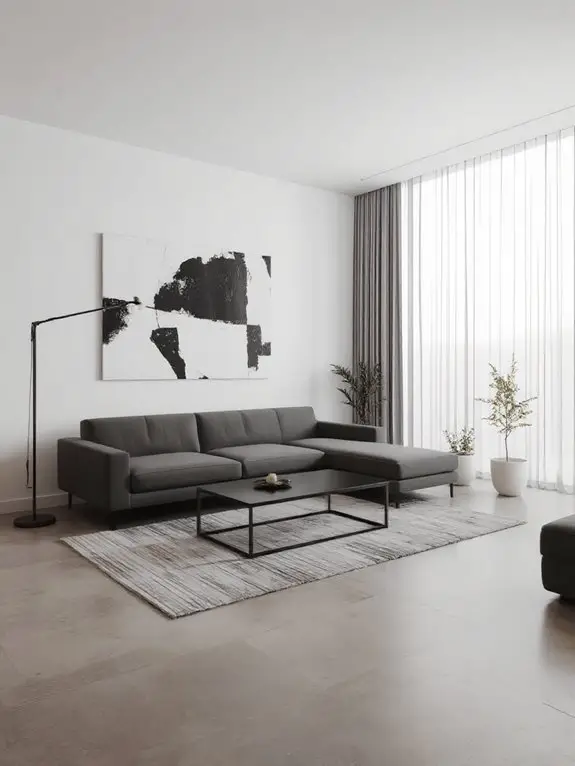
Industrial minimalist fusion blends raw, utilitarian elements with sleek simplicity, creating a striking yet functional aesthetic. I love incorporating exposed brick, concrete, and metal accents to ground the space in an industrial feel.
Pairing these with clean-lined furniture in neutral tones keeps the look refined and uncluttered. Lighting is key—think sleek pendant lights or black metal floor lamps to amplify the vibe.
I often use open shelving or modular storage to maintain an airy feel while showcasing functional items. Textured rugs or leather accents add warmth without overwhelming the design.
This style is perfect for balancing edginess with calm, making it a standout choice.
Earthy Palette With Clean Lines
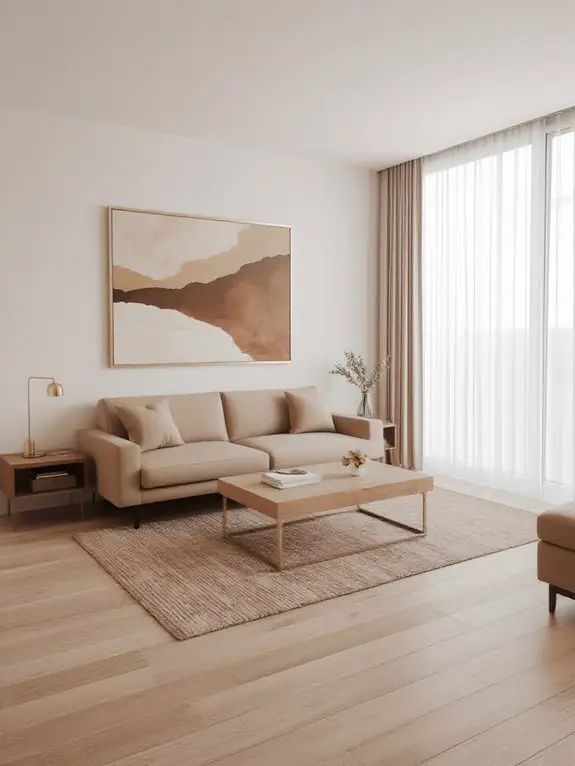
When blending an earthy palette with clean lines, I focus on creating a harmonious balance between natural warmth and modern simplicity. I start with neutral tones like beige, taupe, and warm gray, then layer in earthy elements like wood, stone, and woven textures.
These materials add depth without overwhelming the space. Furniture with sleek, geometric shapes keeps the look refined, while soft linen or cotton fabrics introduce subtle comfort.
I avoid clutter, opting for a few statement pieces like a wooden coffee table or a large potted plant. This approach guarantees a calming, grounded atmosphere that feels both contemporary and organic.
Luxurious Minimalism With Metallics
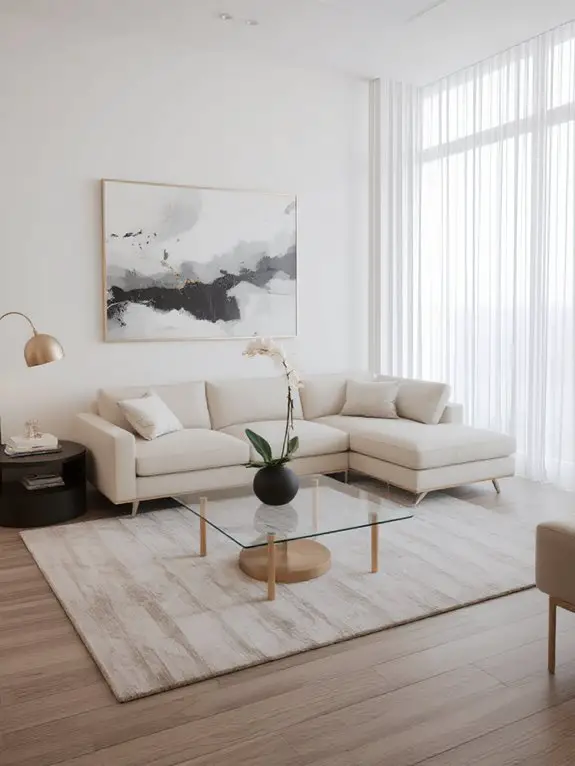
Building on the natural warmth of earthy palettes, incorporating metallics into minimalist spaces introduces a layer of sophistication and refinement. I love using brushed gold or chrome sparingly—think accent pieces like sleek side tables, light fixtures, or decorative objects.
Metallics reflect light beautifully, adding depth without overwhelming the simplicity of the design. I often pair them with neutral tones like ivory or charcoal to keep the focus on their shimmer.
It’s essential to balance the shine—too much can feel flashy, but just the right amount elevates the space. This approach marries luxury with restraint, creating a modern yet timeless aesthetic.
Cozy Minimalist Nook
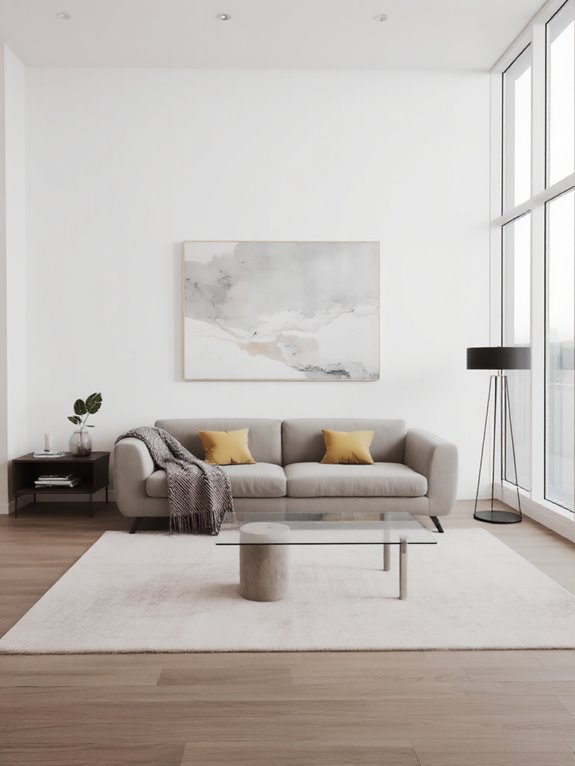
Although minimalist design often emphasizes open, airy spaces, creating a cozy nook within this aesthetic is entirely achievable with thoughtful planning. I start by selecting a soft, neutral-toned armchair or bench, ensuring comfort without clutter.
Layering a textured throw and a few carefully chosen pillows adds warmth. A small side table or shelf keeps essentials handy but unobtrusive.
Strategic lighting, like a minimalist floor lamp or a single pendant, enhances the intimate vibe. I avoid overcrowding, sticking to a few meaningful decor pieces—a plant, a simple vase, or a single framed artwork. This approach balances coziness with minimalism’s signature clean lines.
Airy Space With Floor-To-Ceiling Windows
To maximize the sense of openness in a living room with floor-to-ceiling windows, I focus on maintaining clean lines and uncluttered surfaces. I choose furniture with sleek, low profiles to avoid obstructing the view and let natural light flood the space. Neutral tones like white, beige, or gray dominate the palette, enhancing the airy feel.
Sheer curtains or no window treatments at all guarantee unobstructed sightlines. I opt for minimal decor—perhaps a single statement plant or artwork—to keep the focus on the outdoors. The result is a tranquil, spacious environment that feels seamlessly connected to nature.
Minimalist Mid-Century Modern
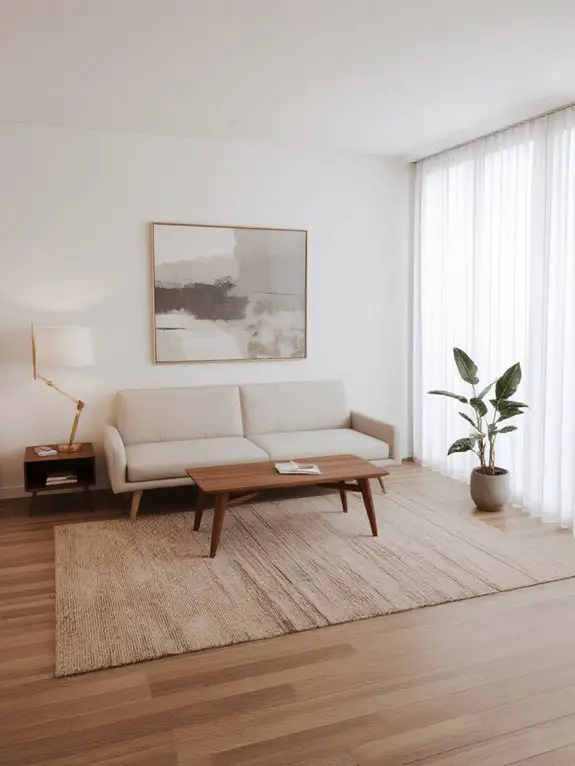
I embrace the clean, functional elegance of a minimalist mid-century modern living space by blending timeless design elements with pared-down aesthetics. I focus on iconic furniture pieces like sleek, low-profile sofas, teak or walnut accents, and geometric shapes.
Neutral palettes with pops of mustard yellow, olive green, or burnt orange add warmth without clutter. I avoid excessive decor, letting standout items like a vintage Eames chair or a Noguchi coffee table take center stage.
Natural materials—wood, leather, and wool—create texture and depth. Clean lines and open layouts keep the space uncluttered, ensuring it feels both inviting and effortlessly timeless.
Zen-Inspired Tranquility
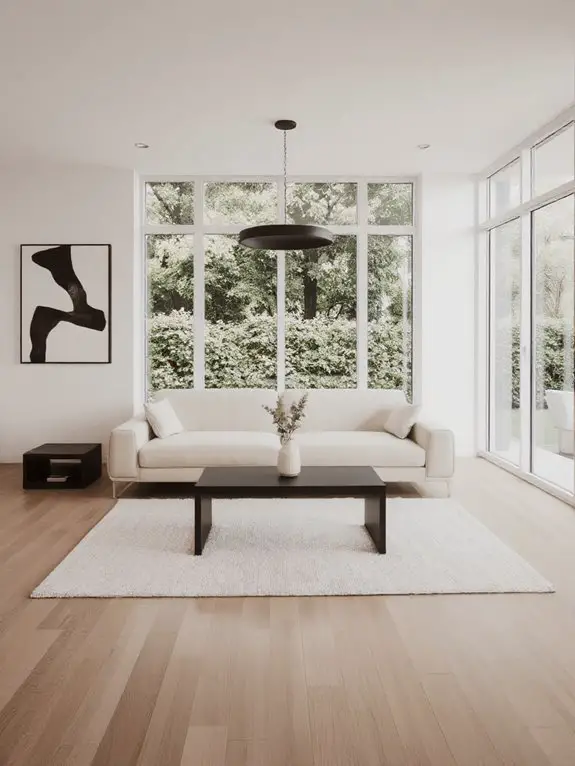
Zen-inspired tranquility transforms a living room into a serene retreat by emphasizing simplicity, natural elements, and mindful design. I focus on creating a harmonious space where every object serves a purpose, avoiding clutter to promote calm.
I incorporate materials like wood, stone, and bamboo to bring nature indoors, fostering a grounded atmosphere. Soft, neutral tones dominate the palette, while natural light enhances the openness.
I add subtle accents, such as a low-profile wooden coffee table or a simple indoor plant, to maintain balance. The goal is to craft a space that feels peaceful, where I can unwind and reconnect with myself.
Bold Black and White Contrast
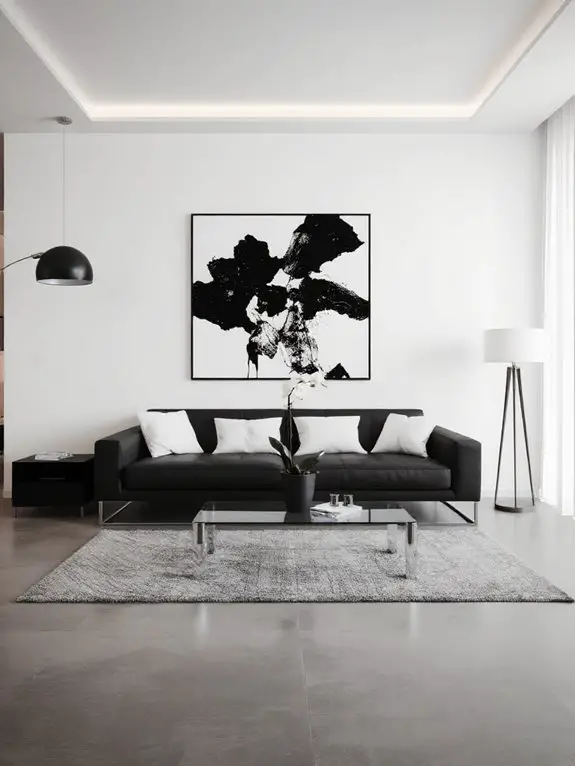
Bold black and white contrast creates a striking, modern aesthetic that instantly elevates a minimalist living room. I love how this high-contrast palette brings drama without clutter, making the space feel intentional and polished.
To nail the look, I stick to clean lines—think a black leather sofa against white walls or a monochrome geometric rug. Balance is key; too much black feels heavy, while too much white can seem sterile.
I layer textures like matte finishes and glossy accents to add depth. Strategic pops of black in lighting or artwork anchor the room, proving simplicity doesn’t have to be boring.
Minimalist Bohemian Flair
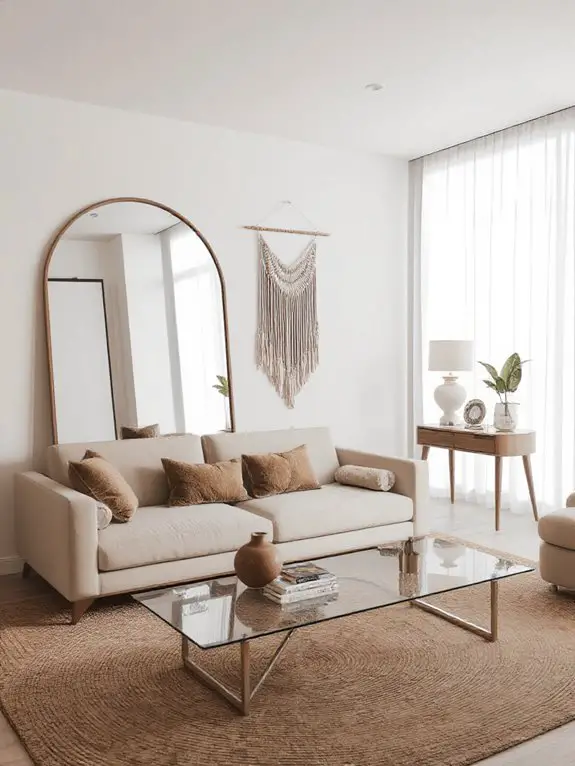
While minimalist design often emphasizes simplicity, blending it with bohemian flair introduces warmth and character without overwhelming the space. I like to achieve this by layering textures like a woven jute rug, linen throws, and a few patterned cushions.
Earthy tones—think terracotta, olive green, and soft beige—bring in a grounded vibe. I incorporate handmade ceramics or macramé wall hangings as focal points, adding personality while keeping clutter at bay.
A single statement plant, like a fiddle-leaf fig, breathes life into the room. The key is balancing minimalism’s clean lines with bohemian elements that feel intentional, not chaotic.
Functional Art Deco Minimalism
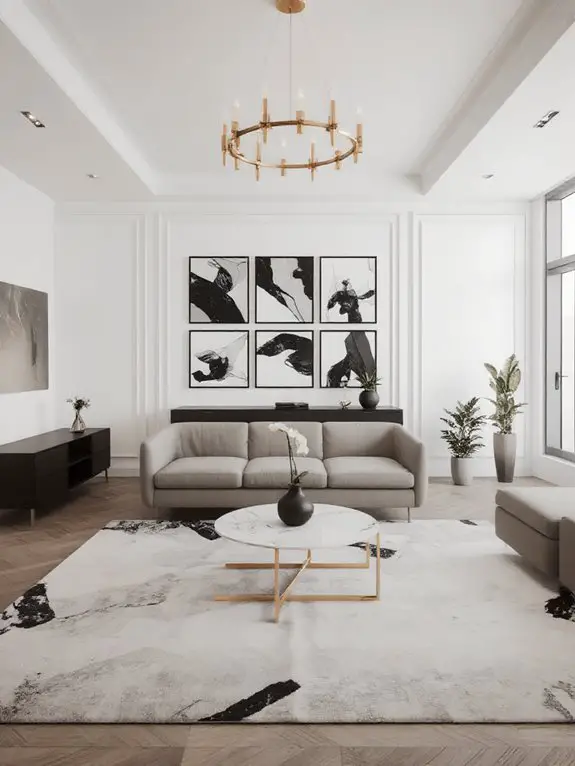
Though Art Deco is often associated with opulence, blending its geometric elegance with minimalist principles creates a striking yet functional aesthetic. I focus on clean lines and bold shapes, like sleek chevron patterns or symmetrical furniture, but keep the palette subdued—think black, white, and metallic accents.
I choose a few standout Art Deco-inspired pieces, such as a streamlined armchair or a geometric coffee table, to serve as focal points without overwhelming the space. Mirrors with angular frames and subtle lighting fixtures enhance the room’s depth and drama.
This approach balances sophistication with simplicity, making it both livable and visually compelling.
Warm Minimalist Aesthetic
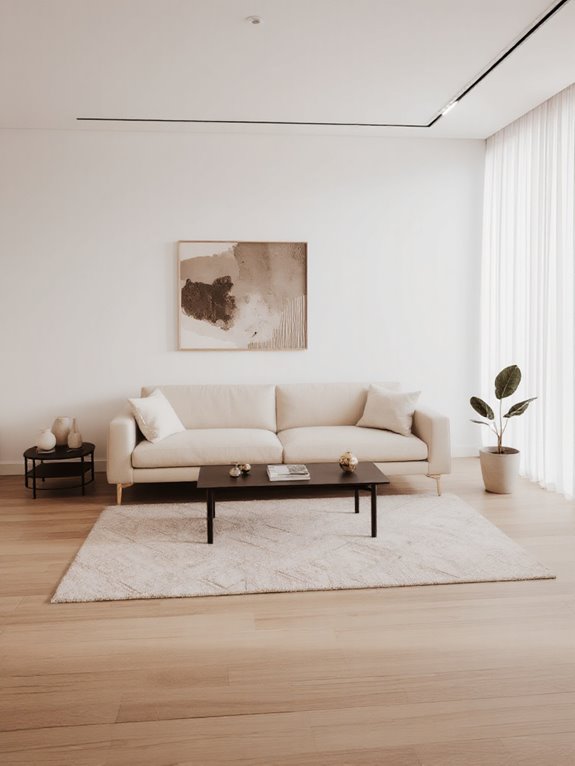
A warm minimalist aesthetic brings comfort into clean, uncluttered spaces by layering natural textures and soft tones. I love incorporating linen sofas, wool rugs, and wooden accents to add depth without overwhelming the simplicity.
Neutral palettes with hints of beige, warm white, or soft gray create a calming atmosphere. Strategic lighting, like warm LED bulbs or diffused lamps, enhances the coziness.
I keep decor minimal but meaningful—think a single statement plant or textured ceramics. This approach balances functionality with warmth, making the room feel inviting yet orderly.
It’s perfect for those who want a serene space that still feels lived-in and personal.
Minimalist Home With a View
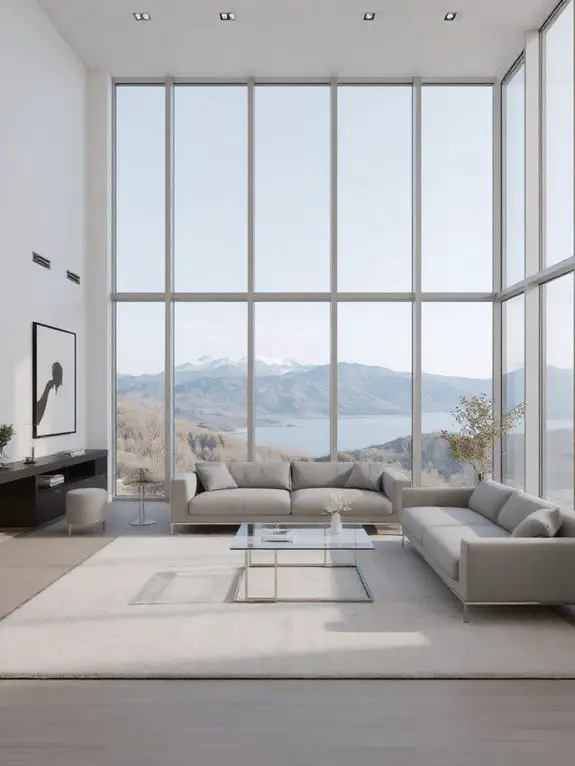
When designing a minimalist home with a view, it’s essential to let the natural surroundings take center stage. I focus on selecting large, unobstructed windows or glass walls to maximize the connection between indoors and outdoors.
Neutral tones and simple materials like wood, stone, and concrete help blend the interior with the landscape. I keep furniture minimal, opting for low-profile pieces that don’t compete with the view.
Strategic lighting enhances the space without overwhelming it, and I avoid clutter to maintain a sense of serenity. Every element is intentional, ensuring the home complements its environment rather than dominating it.
Geometric Patterns in Minimalist Design
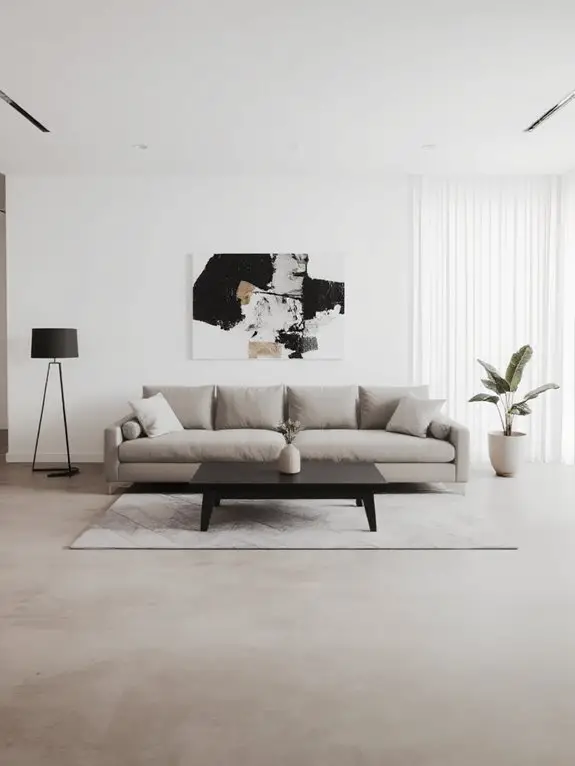
Geometric patterns bring precision and visual interest to minimalist design without compromising its simplicity. I find that incorporating shapes like circles, triangles, or hexagons through rugs, wall art, or even furniture adds depth to a space while maintaining a clean aesthetic.
For instance, a black-and-white geometric rug can anchor a neutral-toned room without overwhelming it. I also recommend using patterns sparingly—focus on one statement piece to avoid clutter.
Pairing geometric elements with soft textures, like a smooth leather sofa or plush throw, creates balance. This approach guarantees the design feels intentional and cohesive, elevating the minimalist vibe effortlessly.
Minimalist Living With Green Touches
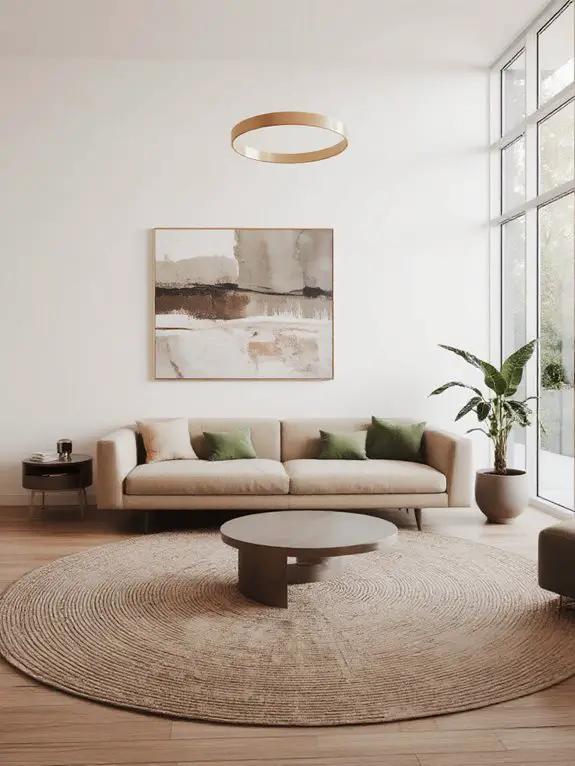
Incorporating greenery into a minimalist living room transforms the space into a serene, nature-inspired haven without sacrificing its clean aesthetic. I always opt for simple, sleek planters that complement the room’s neutral palette, placing them strategically to add life without clutter.
A tall fiddle-leaf fig in a corner or a cascading pothos on a shelf can become a focal point. I also love using small potted succulents or air plants for subtle touches.
Beyond aesthetics, plants improve air quality and bring a calming energy. It’s a balance—choosing greenery that enhances the room’s simplicity while fostering a connection to nature.
Urban Loft Minimalism
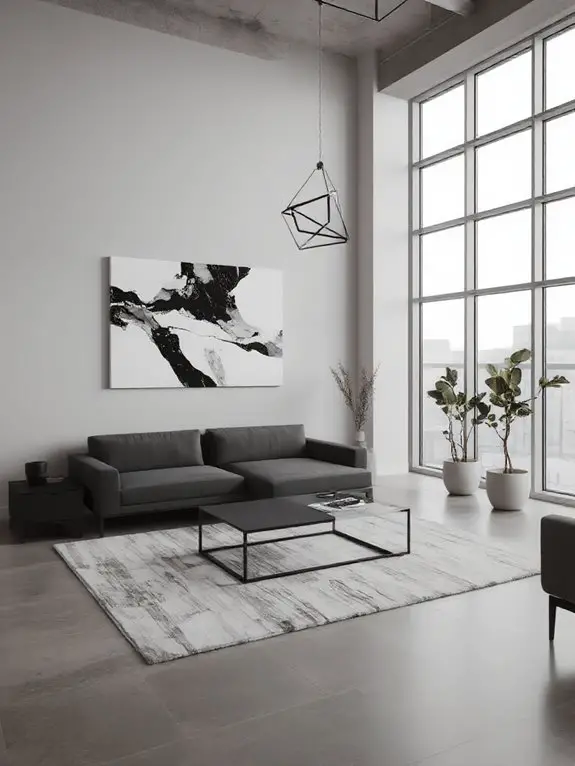
Urban loft minimalism embraces the raw, industrial charm of open spaces while maintaining a clean, uncluttered aesthetic. I focus on exposing structural elements like exposed brick, concrete floors, and steel beams to highlight the space’s authenticity.
Neutral tones like gray, black, and white dominate the palette, creating a serene atmosphere. I keep furniture sleek and functional, often opting for modular pieces that adapt to the layout. Large windows are essential, flooding the room with natural light.
Minimal decor—such as industrial lamps or abstract art—adds personality without overwhelming the space. It’s about celebrating simplicity within an urban, industrial framework.
Minimalist Cottage Charm
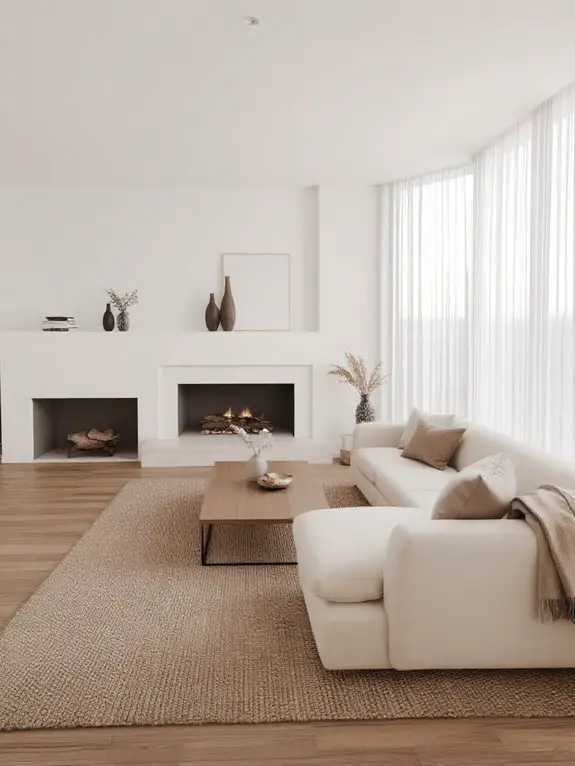
While minimalist cottage charm might seem at odds with the simplicity of minimalism, it’s all about blending cozy warmth with a pared-down aesthetic. I’ve found that incorporating natural materials like wood and linen adds warmth without clutter.
Soft, neutral tones—think creamy whites and soft grays—create a serene backdrop, while a few carefully chosen rustic elements, like a weathered bench or a simple woven basket, enhance the cottage vibe.
I keep furniture streamlined but comfortable, opting for pieces with clean lines but plush cushions. It’s a balance that makes the space feel inviting yet intentional, cozy yet uncluttered.
High-Contrast Minimalist Decor
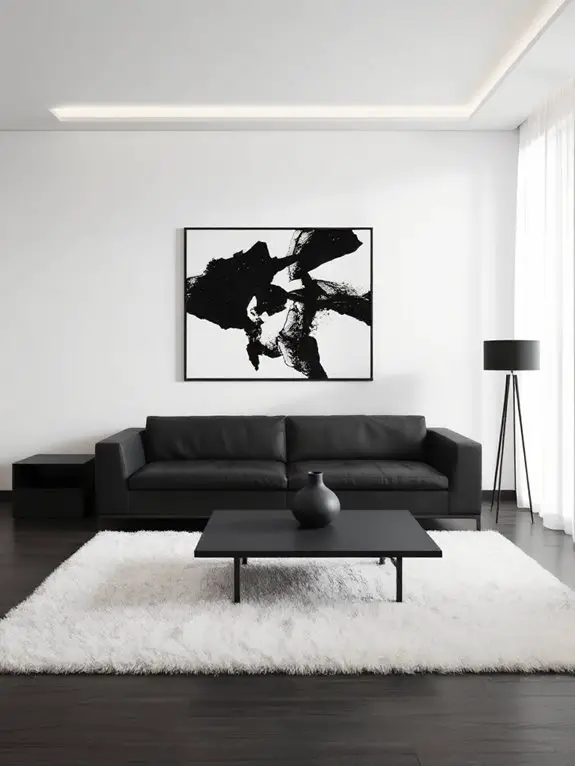
Shifting from the cozy warmth of minimalist cottage charm, I find high-contrast minimalist decor offers a bold, striking approach to simplicity. This style leans on a limited color palette—typically black, white, or gray—paired with sharp architectural lines and uncluttered spaces.
I focus on balancing light and dark elements, like pairing a black feature wall with white furniture, to create visual interest without overwhelming the room. Texture plays a subtle role here, with materials like leather, metal, or concrete adding depth.
The key is restraint; I avoid excessive decor, letting the contrast speak for itself while maintaining a serene, modern ambiance.
Minimalist Studio Apartment Design
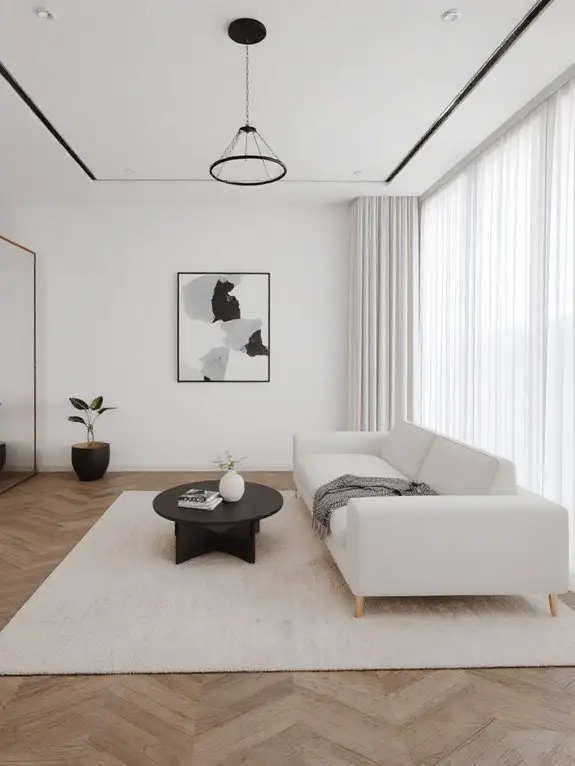
To maximize the potential of a minimalist studio apartment, I prioritize functionality without sacrificing aesthetics. I start by selecting multipurpose furniture, like a sleeper sofa or a foldable dining table, to save space.
I stick to a neutral color palette with subtle textures to create a sense of calm and openness. Vertical storage solutions, such as floating shelves, help keep surfaces clutter-free.
Proper lighting is key—I layer ambient, task, and accent lights to enhance the room’s depth. Finally, I limit decor to a few statement pieces that reflect my personality, ensuring the space feels curated yet uncluttered.
Timeless Minimalist Family Room
Creating a timeless minimalist family room starts with balancing simplicity and practicality. I focus on choosing a neutral color palette—whites, grays, and earth tones—to create a calming space. Low-profile furniture with clean lines maximizes functionality without overwhelming the room.
I prioritize multi-purpose pieces, like a sleek sofa with hidden storage or a modular coffee table. Lighting is key; I opt for soft, ambient fixtures and incorporate natural light whenever possible.
Textures from rugs, throws, and cushions add warmth without clutter. To conclude, I keep decor intentional—a few meaningful items or artwork—to maintain a serene, cohesive look that’s both stylish and livable.
Frequently Asked Questions
How to Maintain Cleanliness in a Minimalist Living Room?
Imagine a dust bunny army staging a coup on your pristine surfaces—don’t let it happen. I ditch clutter daily, dust weekly, and use multi-purpose cleaners. Storage? Double as decor. It’s survival of the cleanest here.
What Are Budget-Friendly Minimalist Decor Ideas?
I’m always looking for budget-friendly minimalist decor ideas. I’d focus on decluttering first, then add neutral tones, DIY art, and secondhand furniture. Plants and simple textiles can bring warmth without breaking the bank.
Can Minimalist Design Work in Small Spaces?
A sparrow builds its nest with just enough—no excess. I’ve found minimalist design thrives in small spaces, turning limitations into liberation. Decluttering and choosing multifunctional pieces create breathing room, making my tiny haven feel expansive and serene.
How to Incorporate Personal Items Without Cluttering?
I’ll focus on choosing a few meaningful pieces that spark joy and display them intentionally. I’ll use sleek storage solutions like hidden shelves or multi-functional furniture to keep things organized without sacrificing personal style or visual calm.
What Lighting Works Best for Minimalist Interiors?
Did you know 75% of people report feeling more relaxed in well-lit spaces? I’ve found that in minimalist interiors, natural light paired with sleek fixtures like recessed lighting or geometric pendants creates a calming, uncluttered vibe. Avoid overly ornate designs.

